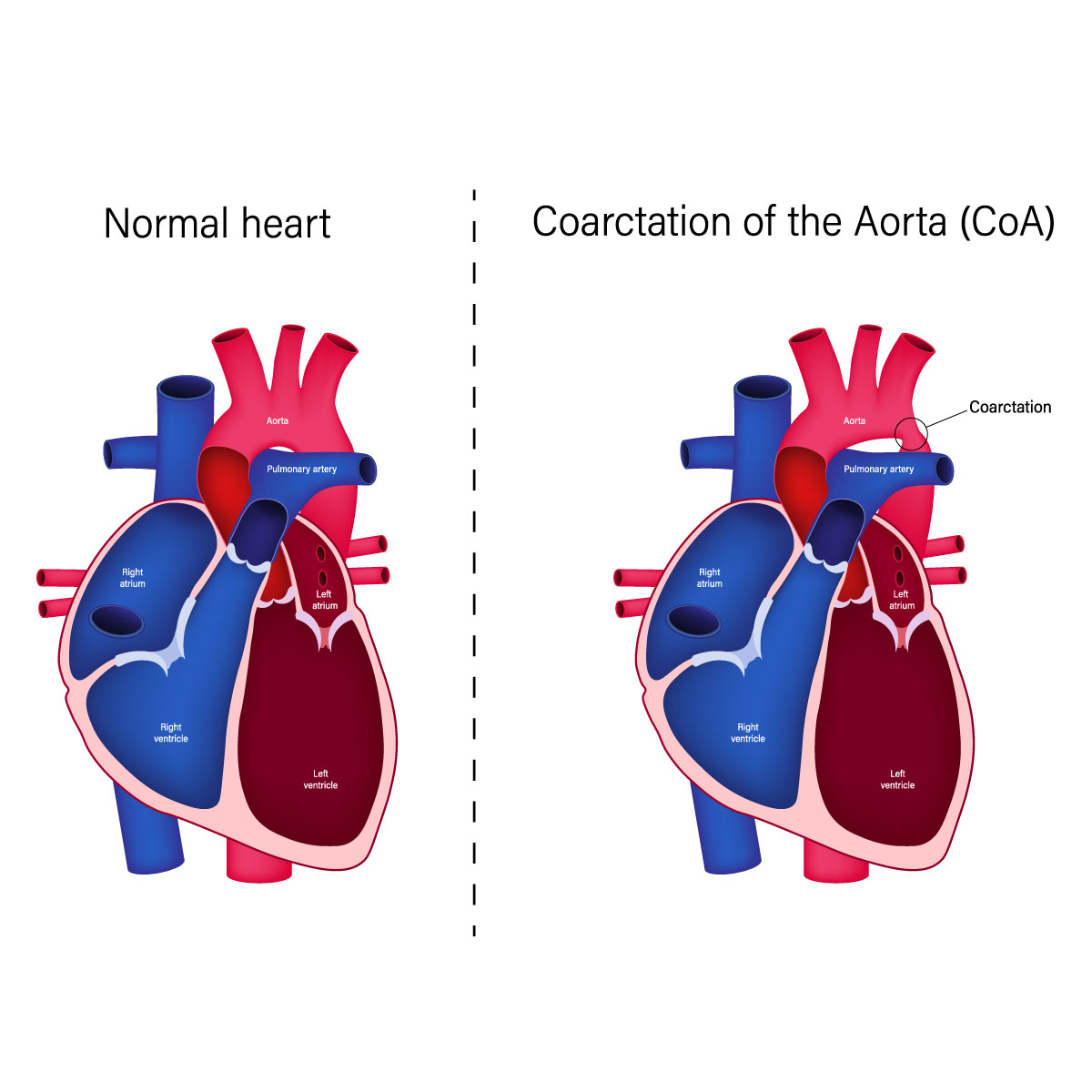
Coarctation of the aorta


Overview
Aortic coarctation is a hereditary heart disease which usually occurs with other congenital heart defects. If aortic coarctation, or the narrowing of the aorta, occurs, the heart must work harder to pump blood through the artery because the aorta is the largest artery responsible for moving oxygen-rich blood from the heart to the entire body. The symptoms vary from mild to severe and it may be undetectable until the person gets older. Aortic coarctation patients are recommended to see a doctor for treatment as the success rate is high if treatment is received on time.
However, most patients must do thorough follow-up for the rest of their life to monitor the symptoms.
Symptoms
In most cases, aortic coarctation does not cause any symptoms. Mild coarctation can become detectable in adulthood. Symptoms can show up in newborns with severe aortic coarctation within a short period of time after birth.
The symptoms that can be found in those newborns with aortic coarctation include:
- Breathing difficulty
- Feeding difficulty
- Excessive sweating
- Recklessness
- Pale skin
After infancy period, the patients with aortic coarctation may experience the following symptoms:
- Chest pain
- Headache
- Hypertension
- Muscle spasm in the legs or feeling cold in the feet
- Weak muscles
- Nasal bleeding
The blood pressure depends on the area affected by the aortic coarctation. For example, the arms tend to have high blood pressure while the legs and ankles tend to have a lower one.
Other congenital heart conditions that happen together with aortic coarctation can cause any other symptoms too, depending on what the other illness is.
A child with any of the following symptoms is recommended to see a doctor:
- Severe chest pain
- Passing out
- Sudden difficulty breathing
- Hypertension without known causes
Causes
The cause of aortic coarctation is still not clear. As it is a congenital heart disease, it is mostly found since birth and barely develops after infancy.
However, the risk of developing aortic coarctation can be raised with any of the following factors:
- Severe trauma
- Atherosclerosis, or the thickening of the arteries
- Takayasu arteritis, of arterial inflammation
Although aortic coarctation can happen in any area of the aorta, the ductus arteriosus, or the blood vessel that connects the left pulmonary artery to the aorta, is at the most common location of the disease.
The wall of left ventricle is the highest risk of becoming thickened (hypertrophy). The reason for this is because once the aorta is narrowing, the left ventricle must pump blood harder through the narrowed aorta, causing the blood pressure in the chamber to be higher which causes its wall to thicken.
Risk factors
Genetic disorders and sex are among the risks of coarctation of the aorta. For example, having a genetic disease like Turner syndrome or being a male put one at a higher risk of developing this heart condition.
Aortic coarctation patients tend to have other congenital heart diseases too which puts them at higher risk. They include:
- Bicuspid aortic valve: a disorder where a patient has only two flaps (cusps) instead of three like normal people. The heart’s left ventricle is separated from the aorta with this aortic valve.
- Subaortic stenosis: This disease causes the area below the aortic valve to narrow, blocking the blood flow from left ventricle to aorta.
- Patent ductus arteriosus: This abnormality occurs when a newborn’s ductus arteriosus, or a blood vessel that connects the left lung artery to the aorta, remains open after childbirth. Usually, this blood vessel is open when the baby is still in the womb to let blood circulate around the lungs and will close right after the baby is born.
- Leaky wall between the left and right sides of the heart: This disorder causes the mixing of oxygen-rich blood from the left side of the heart and oxygen-poor blood in the right side of the heart. The disease is called atrial septal defect if the hole is in the heart wall between the upper chambers and called ventricular septal defect if the hole is in the lower chambers.
- Congenital mitral valve stenosis: causes the mitral valve, which is located between the upper and lower left heart chambers, to narrow and obstructs blood flow in the left side of the heart. Symptoms such as panting and difficult breathing especially when exercising or lying down are most common.
Contact Information
service@vejthani.com






















